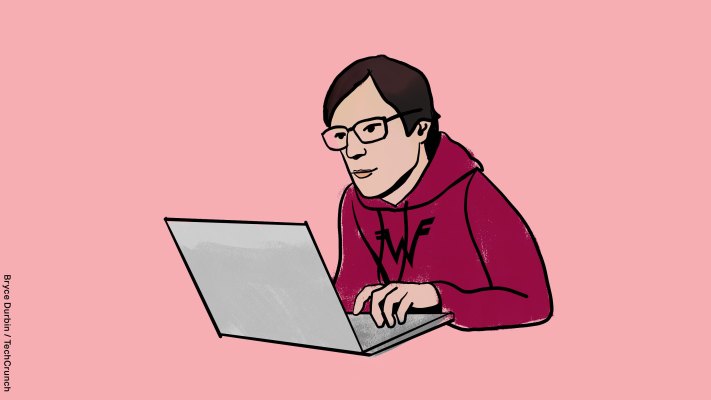“Hi, I’m Rivers from the band, Weezer,” Rivers Cuomo says with a slight smile and a wave. He turns away from the camera for a bit, before launching into his best infomercial pitch. “Imagine you’re on tour, and you’re sitting in your dressing room or your tour bus. You’re backstage. You have stage fright, you’re stressing out. You’re pacing back and forth. And then on top of that, your tour manager is constantly calling you, asking you logistical questions.”
As far as internet pitch videos go, it’s not the most universal. If anything, the three-minute clip loses any hope of populist appeal by the end. In a final shot, the singer in a maroon SpaceX hoodie is the last up the ramp onto a private jet. The plane door closes revealing a Weezer flying “W” logo.
“Download Drivetimes now, on GitHub,” Cuomo adds in voice-over. “This is CS50X.”
It’s not the most polished app pitch video, and Cuomo’s elevator pitch could probably do with a bit of refining before approaching venture capitalists about a seed round. As far as final projects for online programming courses go, however, it’s something to behold. The images alternate between pages of code, Google spreadsheets and POV shots as he takes the stage for a co-headlining tour with the Pixies.
It helped earn Cuomo a 95 in the class.
But while, in its current configuration, the Drivetime tour scheduling tool might have limited appeal, the musician’s final project from Harvard’s follow-up course, CS50W, is immediately apparent for an army of fans who have followed his quarter-century-plus career. This week Cuomo dropped more than 2,400 demos totaling more than 86 hours. Spanning 1976 to 2015, the songs range in quality from tape-recorded sketches to more polished fare. Some would eventually find their way onto Weezer’s 13 albums, or assorted side projects. Others wouldn’t be so lucky.
Available through Cuomo’s “Mr. Rivers’ Neighborhood” site, the tracks are gathered into nine bundles, each available for $9 a piece. “By the way,” Cuomo writers at the bottom of a disclaimer, “this market is my final project for a course I’m taking in web programming.”
For half-a-decade, the platinum-selling rock star has been moonlighting as a computer programming student.
“I was always a spreadsheet guy,” Cuomo tells TechCrunch. “Around 2000, I think I started in Microsoft Access and then Excel. Just keeping track of all my songs and demos and ideas. Spreadsheets got more and more complicated to the point where it was like, ‘Well, I’m kind of almost writing code here in these formulas, except it’s super hard to use. So maybe I should actually do programming instead.’ ”
It would be an odd side hustle for practically any other successful musician. For Cuomo, however, it’s the next logical step. In the wake of the massive success of Weezer’s self-titled debut, he enrolled as a sophomore at Harvard, spending a year living in a dorm. He would ultimately leave school to record the band’s much-loved follow-up, Pinkerton, but two more more enrollments in 1997 and 2004 found the musician ultimately graduating with an English BA in 2006.
CS50 found Cuomo returning to Harvard — at least in spirit. The course is hosted online by the university, a free introduction to computer science.
“I went through some online courses and was looking for something that looked appealing and so I saw the Harvard CS50 was very popular,” Cuomo says. “So I was like, ‘Well, I’ll give this a shot.’ It didn’t take immediately. The first week course was using Scratch. I don’t know if you know that, but it’s like kind of click and drag type of programming, and you’re making a little video game.”
A six-week course stretched out for six months for the musician. That same year, the musician — now a father of two — played dozens of shows and recorded Weezer’s 10th album, the Grammy-nominated White Album.
“When we hit Python halfway through the course,” Cuomo says, “I was just amazed at how powerful it was and intuitive it was for me, and I could just get so much done. Then by the end of the course, I was writing programs that were really helping me manage my day-to-day life as a traveling musician and then also managing my spreadsheets and managing my work as a creative artist.”
For Cuomo, productivity has never been much of an issue. The band has two albums completed beyond this year’s Black Album, and he’s already begun work on two more follow-ups. What has seemingly been a bigger issue, however, is organizing those thoughts. That’s where the spreadsheets and database come in.
The “thousands” of spreadsheets became a database, cataloging Cuomo’s own demos and work he was studying from other artists.
“For years it seemed like kind of a waste of time or an indulgence,” he says. “I should be writing a new song or, or recording a song rather than just cataloging these old ideas, but I’ve found that, years later, I’m able to very efficiently make use of these ancient ideas because I can just tell my Python program, ‘Hey, show me all the ideas I have at 126 BPM in the key of A flat that start with a third degree of the scale and the melody and are in Dorian mode and that my manager has given three stars or more to.’ ”
He admits that the process may be lacking in some of the rock and roll romanticism for which fans of the bands might hope. But in spite of drawing on pages of analytics, Cuomo insists there’s still magic present.
For Cuomo, productivity has never been much of an issue. Given his level of productivity, however, organizing all of those thoughts can get tricky. That’s where the spreadsheets and database come in.
“There’s still plenty of room for spontaneity and inspiration in what we traditionally think of as human creativity,” Cuomo explains. “One of my heroes in this realm is Igor Stravinsky. There’s a collection of his lectures called “The Poetics of Music.” And he had a note in that collection. He said he has no interest in a composer that’s only using one of his faculties, like a composer that says, ‘I am only going to write what pops into my head spontaneously when I’m in some kind of a creative zone. I won’t use any of my other tools.’
“He says, ‘No, I prefer to listen to the music of a composer who’s using every faculty at his disposal, his intuition, but also his intellect and his ability to analyze and categorize and make use of everything he has.’ I find that those ended up being the most wild and unpredictable and creative compositions.”
And there’s been no shortage of compositions. Cuomo says the band has two albums completed beyond this year’s Black Album, and he’s already begun work on two more follow-ups. After decades of feeling beholden to the 18-month major label album release cycle, the singer says that after the Demos project, he has a newfound interest in finding more ways to release music directly to fans.
“I don’t feel like I’m really good at understanding the big-picture marketplace and how to make the biggest impact in the world,” he says. “My manager is so good at that, but I just told them like, ‘Hey, this feels like something here. First of all, it’s really fun. The fans are really happy. It’s super easy for everyone involved.’ The coding part wasn’t easy, but for everyone else, it’s a couple of clicks and you’ve got all this music, and it’s a cheap price, and there’s no middleman. PayPal takes a little bit, but it’s nothing like a major label. So, this could be something. And there’s just something, it feels so good when it’s directly from me to the audience.”
For now, computer science continues to take up a major chunk of his time. Cuomo estimates that he’s been spending around 70% of his work hours on programming projects. On Wednesday nights, he helps out with programming for a meditation site (another decades-long passion), and he plans to take Harvard’s follow-up CS50M course, which centers around developing for mobile apps.
There are, however, no immediate plans to quit his day job.
“I can’t see me getting a job at a startup or something or maintaining somebody’s website,” he says. “But maybe the line between rock star and web developer is getting blurred so that musicians will be making more and more use of technological tools. Besides just the music software, we’ll be making more and more use of means of distribution and organization and creativity that’s coming out in the way we code our connection to the audience.”


